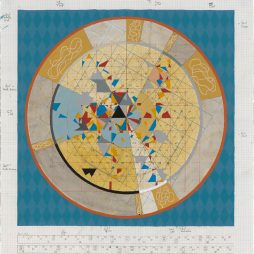Jo Darvall
A new exhibition at Linton and Kay Galleries sees Jo Darvall - born in Melbourne, but now attached to the landscape of the Western Australian Wheatbelt - meditate on the co-constitutive nature of the landscape and those who live, and paint, within it.
Just off-centre in Jo Darvall’s Mooro Katta No. 4, 2020, is a stroke of warm, rambunctious yellow paint; it forms the shape of an arrow, pointed left. Below this, an arrow, this time in earthen brown, points down to the bottom of the frame. Following the perspective of the painting back through the forest of native trees, a denser and denser field of these strokes appear. Are they instructive, signs from the landscape to the viewer? Or, are they remnants of the artist’s own movement – intellectual, imaginative, dexterous – in her encounter with the land?
Dr Kevin Robertson, in an essay accompanying Darvall’s show, writes that, in her paintings, ‘with miles of Wheatbelt and the enormous expanses of arid woodland then desert, there are no obvious vistas – just a vastness that defies quantification. While cameras can record the material facts of the gravel and the stippled bark of this environment, for Darvall, it is this intangible space that she sets about articulating through her work.’ The space between trees in the Wandoo Forest near Mount Observation – a fitting place, indeed, to be Darvall’s ground of choice – expands into the horizon of her works: into the blues and creamy greys of Moroo Katta No. 4, the soft pinks of Mooro Katta, 2020, and the wisps of grey and olive green in Wandoo, 2021. This space also stretches out in to the foreground of many of Darvall’s images – expanse, emptiness, and the possibility of play extended like an open palm towards us.
It is within this space that the motion, the action, of Darvall’s landscapes moves. The landscape might be, on the one hand, animated by Darvall in these instances: fields of ground swell and twist beneath the brush, trunks of trees vibrate with colour, and horizon lines wend between the trees in front of them, ducking and weaving through any structural ‘stability’ that landscape – as a genre – might be supposed to provide. With Darvall, the landscape moves in excess of its generic frame. This work is no polemic, though – it is much more nuanced than that. Darvall’s landscapes, that is, are in other senses animated by the artistic traditions and histories that their visual movement and fluidity resists; Dr Robertson sees, in this work, the spectres of Kathleen O’Connor and Anne Maughan, to which we might also add Guy Warren.
The movement of these landscapes, however, might also be the trace of the action of the land upon Darvall, as much as it is the other way around. Look, for example, at the way that Wandoo sets the ground high up in the frame, embedding the viewer within the ground of the forest, by the trunks and branches of which we are completely enveloped. In this light, the arrow-shapes appearing in Mooro Katta No. 4 might appear less like Darvall’s animation of the land, than the land’s own activation, its own instruction and provocation to the painter, and the viewer in turn. In this way, Darvall’s work becomes an exercise in landscape painting which upsets the position of the artist separate to, and looking plainly at, an objective landscape. These paintings, instead, work at the interstices of the subject and the setting, the viewer and the view, the moving and the moved.















